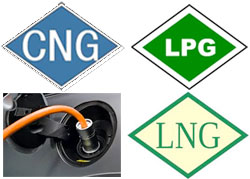CNG and LPG Fuel and Fueling Station Considerations
In October of 2013, Ryder Truck offered the following article outlining the company's experience with fleet filling utilizing both CNG (compressed natural gas) and LNG (liquified natural gas).
 A Fleet Leasing Report provided by Ryder ® A Fleet Leasing Report provided by Ryder ®
Fleets that are considering buying natural-gas vehicles or retrofitting diesel rigs have many factors to consider beyond the cost of vehicles, fuels and the benefits of lower-carbon footprints.
There's a lot to learn from the experience of Ryder Systems, which operates two retail fueling facilities that offer liquefied natural gas (LNG) and compressed natural gas (CNG). This may not seem like a lot of stations, but considering that only about 30 such stations exist across the nation, these two facilities give the company an understanding and expertise not available to most operators, according to Scott Perry, vice president, supply management, in Miami, Fla.
First, fleets considering LNG should realize how small the LNG fuel network is compared to the number of diesel outlets. "It's going to take a number of years for there to be enough infrastructure in place so that planning for fueling doesn't require extra time to route your truck. You also have to learn what stations are available, how efficient they are and whether they accept equipment such as a combination tractor/trailer configuration," says Perry.
Furthermore, it is crucial that these stations' dispensers accept your form of payment—not just the usual credit cards—and if they offer data for your back office beyond price and number of gallons dispensed. "That's a common and important shortcoming today," says Perry.
Technically, it's essential to understand how differently LNG fills compared to diesel. For CNG, fill rates deteriorate as more vehicles are filled before you. "If you're the fifth truck in the line that morning—and they've exhausted the standby capacity of the station and are operating solely off of the compressor—instead of getting a fill at 10 or 12 gallons per minute, you may be getting a fill at one or two gallons per minute," Perry says. For a 75-gallon diesel equivalent tank, a 5-to-7 minute fill-up can take 30 minutes. This is not a problem with LNG. "One of the benefits of LNG is that it is very much like diesel from a flow-rate standpoint."
Perry adds: "There are some benefits and some tradeoffs to the time-fill versus a fast-fill solution. When you're transferring a high volume of fuel into the vehicle storage tanks, heat can build up, which can prevent you from taking on a full fill of fuel.
"If you have 75 diesel equivalent gallons of storage, you may only be capable of taking on 65 diesel gallon equivalents of fuel. That has to be taken into consideration. You have to determine how much range is required for the operation of that vehicle throughout the day." For some fleets, such as buses, a protracted filling during overnight hours, a time-fill, is not an issue. For others, it would be a deal killer.
Lastly, there's the issue of learning how to fill. "Training is required for the dispensing of both, but the low temperature of LNG has a little higher burden for training. The fuel requires special handling because of its cryogenic nature."
|
